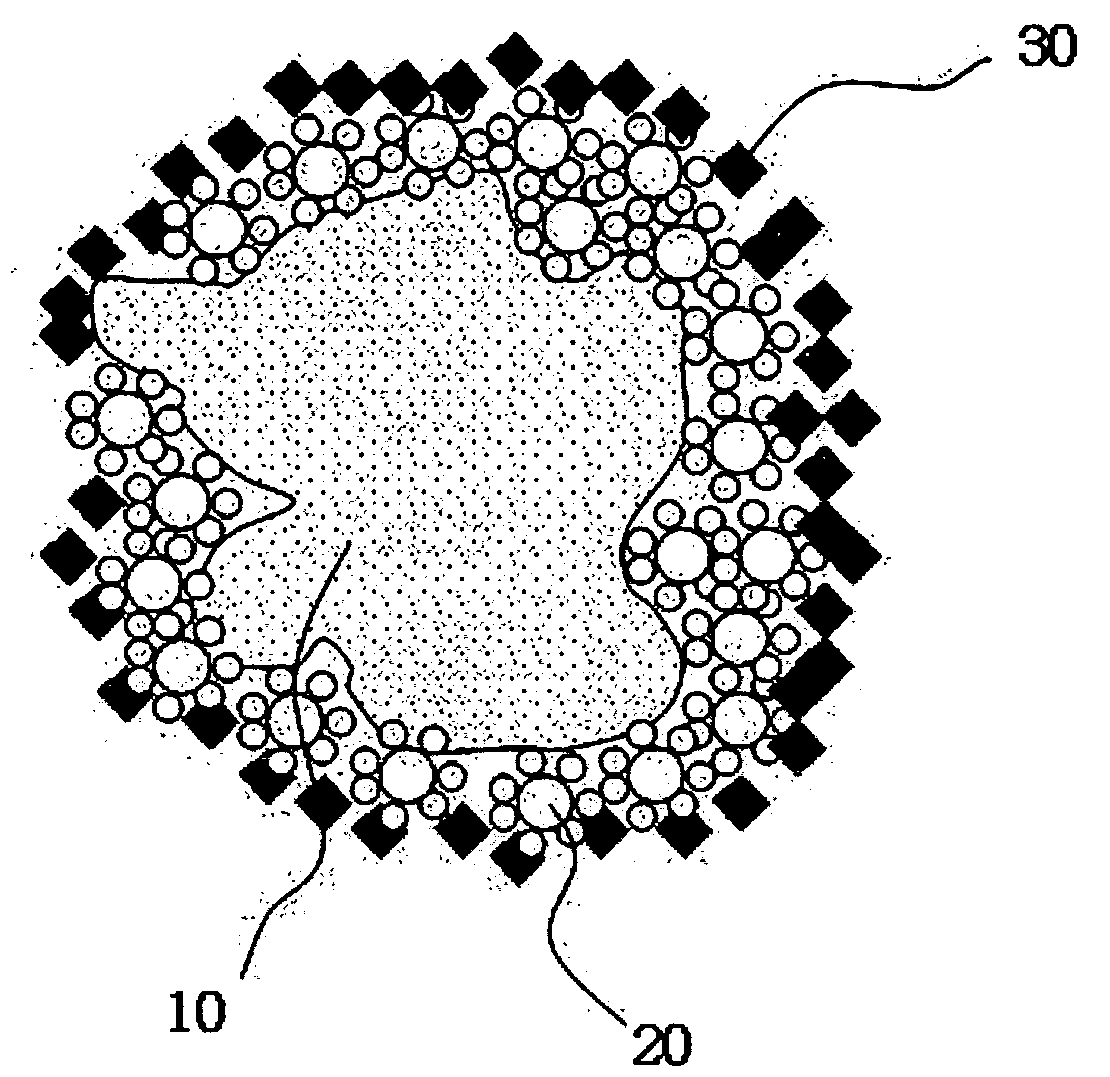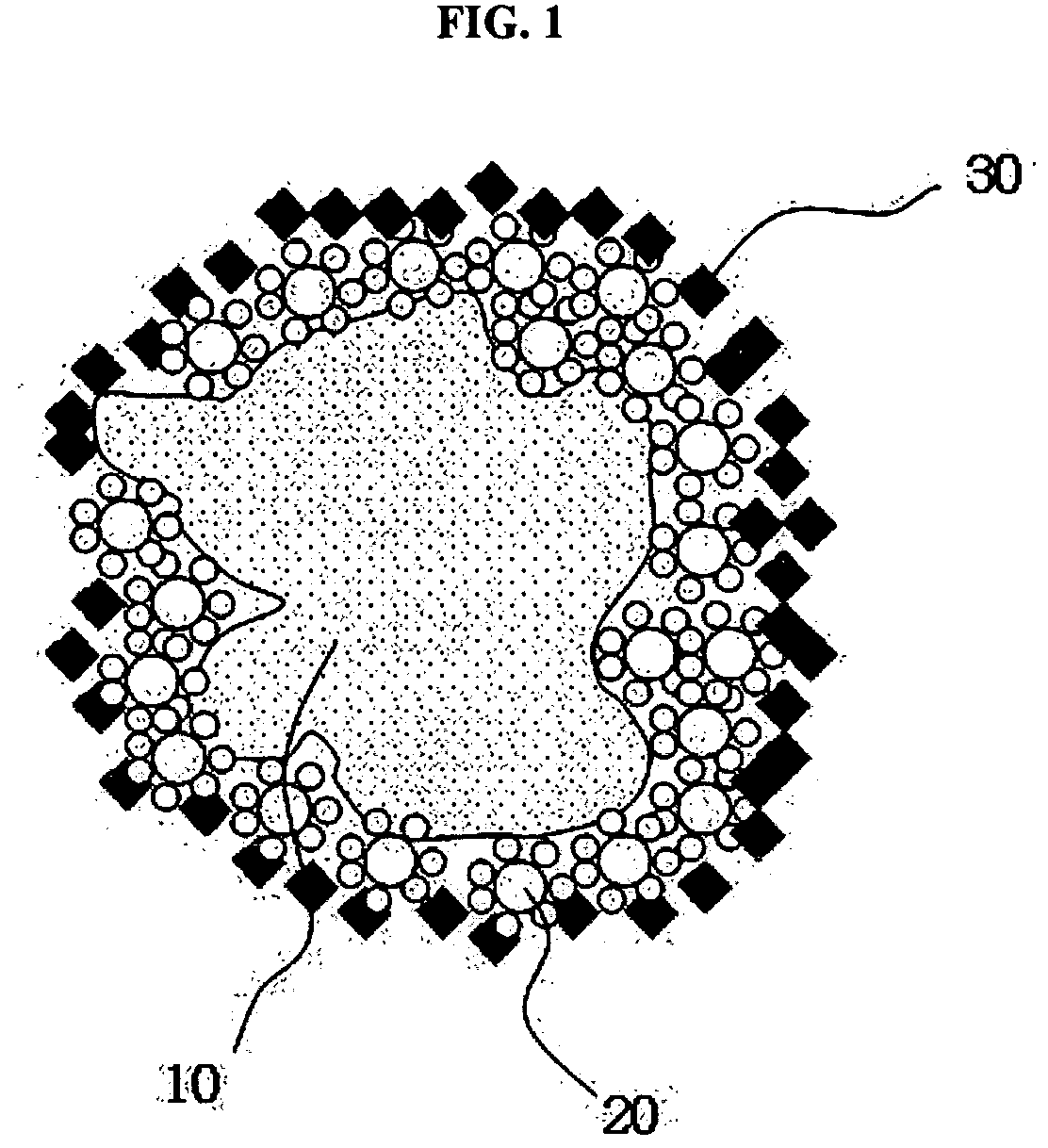Color toner for non-magnetic mono-component system for increasing printing quality and a method for preparing the same
- Summary
- Abstract
- Description
- Claims
- Application Information
AI Technical Summary
Benefits of technology
Problems solved by technology
Method used
Image
Examples
example 1
[0077] 1-1: Preparation of Cyan Toner Mother Particle
[0078] 94 parts by weight of polyester resin (molecular weight=2.5×105), 5 parts by weight of phthalocyanine P.BI.15:3, 1 part by weight of azo metal complex as a charge control agent, and 3 parts by weight of polypropylene having a low molecular weight were mixed using a HENSCHEL mixer. The mixture was melted and kneaded at 165 □ using a twin melt kneader, crushed using a jet mill crusher, and classified using an air classifier to obtain a toner mother particle having a volume-average particle size of 7.2 μm.
[0079] 1-2: Preparation of the First Coating Layer
[0080] Based on 100 parts by weight of the toner mother particle prepared as above, 0.5 parts by weight of polytetrafluoroethylene (PTFE) having an average particle size of 0.1 μm and 0.5 parts by weight of PMMA having an average particle size of 0.1 μm as a spherical organic powder were mixed using a HENSCHEL mixer at a tip speed of 5 m / s to coat each other. The toner moth...
examples 2 to 25
[0084] To test the effect of the particle size and the amount of spherical organic powders on the toner characteristics, Examples 2-25 were prepared according to substantially the same method as in Example 1, except that the compositions were as shown in Table 1. Each example used polytetrafluroethylene (PTFE), polymethylmethacrylate (PMMA), polyvinylidene fluoride (PVDF), and silicon powder as the organic powders. The number average particle size and the amount of the organic powders ranged from 0.1 to 1.5 μm, and 0.5 to 1.5 parts by weight, respectively.
TABLE 1Inorganic powderSilicaTitaniumaveragedioxideOrganic powderparticle size,average particle(average particle size,amountsize, amountmaterial, amount(parts by(parts by(parts by weight))weight)weight)Example 20.1 μm, PTFE, 0.56 nm / 2.5150 nm / 1.00.4 μm, PMMA, 0.5Example 30.1 μm, PTFE, 0.56 nm / 2.5150 nm / 1.00.8 μm, PMMA, 0.5Example 40.1 μm, PVDF, 0.56 nm / 2.5150 nm / 1.01.5 μm, PMMA, 0.5Example 50.4 μm, PVDF, 0.56 nm / 2.5150 nm / 1.01.5 ...
examples 26 to 43
[0085] To test the effect of the amount and the particle size of silica on the toner characteristics, Examples 26-43 were prepared according to substantially the same method as in Example 1, except that the compositions were as shown in Table 2. The number average particle size and the amount of silica ranged from 6 to 40 nm, and 0.5 to 1.5 parts by weight, respectively.
TABLE 2Inorganic powderSilicaTitaniumaveragedioxideOrganic powderparticle size,average particle(average particle size,amountsize, amountmaterial, amount (parts by(parts by(parts byweight))weight)weight)Example 260.1 μm, PTFE, 0.5 6 nm, 1.0150 nm, 1.00.4 μm, PMMA, 0.5Example 270.1 μm, PTFE, 0.5 6 nm, 2.0150 nm, 1.00.8 μm, PMMA, 0.5Example 280.1 μm, PVDF, 0.5 6 nm, 3.0150 nm, 1.01.5 μm, PMMA, 0.5Example 290.4 μm, PVDF, 1.017 nm, 1.0150 nm, 1.00.1 μm, PMMA, 0.5Example 300.4 μm, PVDF, 1.017 nm, 2.0150 nm, 1.00.8 μm, PMMA, 0.5Example 310.8 μm, PVDF, 1.017 nm, 3.0150 nm, 1.00.1 μm, PMMA, 0.5Example 320.8 μm, PVDF, 1.017 ...
PUM
| Property | Measurement | Unit |
|---|---|---|
| Percent by mass | aaaaa | aaaaa |
| Percent by mass | aaaaa | aaaaa |
| Percent by mass | aaaaa | aaaaa |
Abstract
Description
Claims
Application Information
 Login to View More
Login to View More - R&D
- Intellectual Property
- Life Sciences
- Materials
- Tech Scout
- Unparalleled Data Quality
- Higher Quality Content
- 60% Fewer Hallucinations
Browse by: Latest US Patents, China's latest patents, Technical Efficacy Thesaurus, Application Domain, Technology Topic, Popular Technical Reports.
© 2025 PatSnap. All rights reserved.Legal|Privacy policy|Modern Slavery Act Transparency Statement|Sitemap|About US| Contact US: help@patsnap.com



